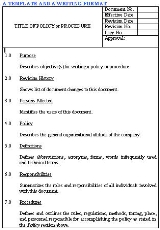
Policies and Procedures
Encyclopedia
Policies and procedures are a set of documents that describe an organization's policies for operation and the procedures necessary to fulfill the policies. They are often initiated because of some external requirement, such as environmental compliance or other governmental regulations, such as the American Sarbanes-Oxley Act
requiring full openness in accounting practices.
Policies and procedures have many names including but not limited to business policies and procedures, standard operating procedures or SOP, or department operating procedures or DOP.
In healthcare, policies and procedures are not only required for the hospital or facility to stay accredited but are also directly related to the consistency and quality of care a patient receives.
Sarbanes-Oxley Act
The Sarbanes–Oxley Act of 2002 , also known as the 'Public Company Accounting Reform and Investor Protection Act' and 'Corporate and Auditing Accountability and Responsibility Act' and commonly called Sarbanes–Oxley, Sarbox or SOX, is a United States federal law enacted on July 30, 2002, which...
requiring full openness in accounting practices.
Policies and procedures have many names including but not limited to business policies and procedures, standard operating procedures or SOP, or department operating procedures or DOP.
In healthcare, policies and procedures are not only required for the hospital or facility to stay accredited but are also directly related to the consistency and quality of care a patient receives.
Standard form
Policy-and procedure writing often uses a standard format within an organization, including a complete history of changes made to the document. Typically, the format includes a purpose, persons affected, scope, sometimes a background section, a policy section, definitions, responsibilities, and a procedures section. The format when put into a template can also include information about the title, effective date, revision date, and an approval section.Need For policies & procedures
There are four very basic reasons that necessitate writing policies and procedures:- Operational needs — Policies and procedures ensure that fundamental organizational processBusiness processA business process or business method is a collection of related, structured activities or tasks that produce a specific service or product for a particular customer or customers...
es are performed in a consistent way that meets the organization's needs. - Risk management — Established policies and procedures are identified by Committee of Sponsoring Organizations of the Treadway CommissionCommittee of Sponsoring Organizations of the Treadway CommissionThe Committee of Sponsoring Organizations of the Treadway Commission is a voluntary private-sector organization, established in the United States, dedicated to providing guidance to executive management and governance entities on critical aspects of organizational governance, business ethics,...
(COSO) as a control activity needed to manage risk. - Continuous improvement — Procedures can improve processes by implementing a Plan-Do-Check-Act (PDCAPDCAPDCA is an iterative four-step management method used in business for the control and continuous improvement of processes and products...
) approach by building important internal communication practices. - Compliance — Well-defined and documented processes (i.e. procedures, training materials) along with records that demonstrate process capability can demonstrate an effective internal control system compliant with regulations and standards.

